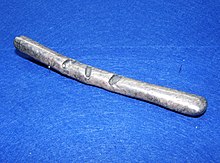User:Renata3/money
| This is not a Wikipedia article: It is an individual user's work-in-progress page, and may be incomplete and/or unreliable. For guidance on developing this draft, see Wikipedia:So you made a userspace draft. Find sources: Google (books · news · scholar · free images · WP refs) · FENS · JSTOR · TWL |
The history of money in the Grand Duchy of Lithuania covers the period to the Third Partition in 1795.
Earliest coins
[edit]
The first known coins in the present-day Lithuania are foreign coins that ended up in Lithuania as a result of trading. There are reports that ancient Greek coins were found in Lithuania, but they are not reliable. In 1962, a silver tetradrachm from Naxos (Sicily) (5th century BC) was found near Glūkas Lake in Varėna District Municipality; it turned out to be a modern reproduction.[1] Two other reports of Greek coins (unidentified coins from Salenikai and a 2nd-century BC silver tetradrachm from Smyrna found in 1936 in Rasos suburb of Vilnius) are known only from literature and therefore cannot be verified.
Much more common are ancient Roman coins found along with other Roman-made artifacts. They signify trade, mostly of Baltic amber, with the Roman Empire. Some 1000 Roman coins, dating from the 1st to 4th century, were found in about 60 different locations of Lithuania, most of them along the Baltic coast.[2] They are mostly brass sestertii found in burials (likely the coins were placed there imitating Charon's obol).[3] There are a couple early coins from the Roman Republic, but likely they were brought with later Roman coins.[4] After the fall of the Western Roman Empire, this trade became extinct.
Some 300 silver Arab dirhem from the 9–11th centuries were found mostly in Eastern Lithuania.[5] Their true number is hard to determine because earlier discoveries were poorly documented and only few coins are kept in museums, but it is clear that these coins are much more common in neighboring countries (some 1800 coins in Latvia and 5000 coins in Estonia).[6] Their appearance in Lithuania is related to the development of the trade route from the Varangians to the Greeks.[5] By the end of 11th century, Arab coins are replaced by dinars of Western Europe,[7] brought by Scandinavian traders, but they are extremely rare.[8]
Silver ingot
[edit]
A silver-based economy developed in the 9th century.[9] Vikings developed bullion-based trading, using hacksilver and ingots.[10] They also developed scales and weights, which are also found in Lithuania. Based on archaeological evidence, two weight systems were identified in Lithuania: one based on Scandinavian mark (about 205 grams (7.2 oz)) and another based on the weight of Arab dirhem (about 4 grams (0.14 oz)). When the flow of Arab coins dried up, a system of commodity money developed that existed from the 10th to 15th century. The system spread widely, including Kievan Rus', and used silver ingots as currency. Trading centers like Kiev, Novgorod, Kraków, developed their own standard shape and size of these ingots that became known as grzywna or grivna.
In Lithuania, the ingot is found in three shapes: coil, bracelet, and stick or finger. The latter shape prevailed and became the standard. In the 12th century, Lithuania developed its own variation of ingots that weighted about 100–104 grams (3.5–3.7 oz) or about half of the Scandinavian mark. In literature these are known as Lithuanian long coins (Lithuanian: ilgieji). Sometimes they are also incorrectly referred to as kopa, ruble, or grzywna.
Groschen
[edit]
Links
[edit]- http://www.dzukuzinios.lt/istorine-lietuvos-pinigu-raida
- http://etno.lt/index.php/en/articles/193-lietuvos-pinigai
- http://www.15min.lt/naujiena/ziniosgyvai/istorija/ldk-istorija-grasis-lietuvos-pinigu-sistemos-pagrindas-582-394127
- http://www.15min.lt/naujiena/ziniosgyvai/istorija/ldk-istorija-aukso-monetos-valstybes-ir-valdovo-paziba-582-395644
- http://elibrary.lt/resursai/DB/LB/LB_pinigu_studijos/Pinigu_studijos_1997_02_04.pdf
- http://www.lad.lt/data/com_ladlibrary/418/313-314.pdf
- http://www.lad.lt/data/com_ladlibrary/161/47-66.pdf
- http://www.delfi.lt/news/daily/lithuania/lietuvoje-iki-siol-ieskoma-ldk-epochos-lobiu.d?id=56791593
- http://www.lnm.lt/virtualios-parodos/monetu-radiniai-lietuvoje?id=353
- http://kladoiskatel.5bb.ru/viewtopic.php?id=114
- http://www.lnm.lt/ekspoziciniai-padaliniai/70-virtualios-parodos/lietuvos-didiosios-kunigaiktysts-numizmatika/146-seniausi-ldk-pinigai-lydiniai
- http://m.ldkistorija.lt/index.php/istoriniai-faktai/pirmieji-pinigai-sidabro-lydiniai-ir-ju-klastojimas/1520
References
[edit]- ^ http://etalpykla.lituanistikadb.lt/fedora/get/LT-LDB-0001:J.04~2004~1367161735057/DS.002.0.01.ARTIC
- ^ http://www.lad.lt/data/com_ladlibrary/161/47-66.pdf
- ^ p105-6
- ^ p. 62
- ^ a b http://www.delfi.lt/news/daily/lithuania/lietuvoje-iki-siol-ieskoma-ldk-epochos-lobiu.d?id=56791593
- ^ p. 175
- ^ p. 158
- ^ p. 222
- ^ http://books.google.com/books?id=ZK3bdq6ihM8C&pg=PA451
- ^ https://www.academia.edu/5437488/Silver_Economies_of_the_Ninth_and_Tenth_Centuries_AD_in_Hedeby p 209
Category:History of money Category:Medieval currencies Category:Currencies of Lithuania Category:History of Lithuania (1219–1569) Category:Early modern history of Lithuania

